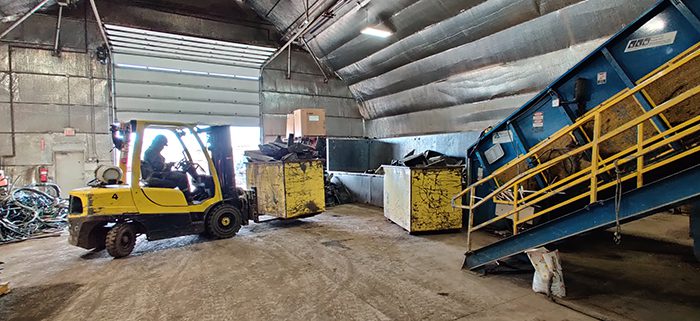Inland Steel Products Facility, Saskatoon

Location: Saskatoon, Saskatchewan
Owner/Operator: Inland Steel Products
Architect: KSA Group Architecture
Construction Management: Hipperson Construction
Established in 1967, Inland Steel Products is Saskatchewan’s largest scrap metal recycler and one of the prairies’ leading scrap metal recycling companies, processing ferrous and non-ferrous metals for industry, business, government, and the general public.
Acoustical separation between warehouse & office spaces
HGC was contracted to assist in the design of the acoustical separation between the processing area and the office spaces of a proposed new head office location in Saskatoon. The project when completed would include a state-of-the-art metal recycling and handling facility, a warehouse, and associated office spaces.
Besides typical warehouse sounds, the most significant source of noise at the facility was expected to be a non-ferrous metal baler which would be located in the warehouse. Our main objective was to consider the noise from this equipment in the design of the demising wall and associated perimeter / penetration details between the warehouse and the office areas to ensure proper acoustical separation would be achieved.
Comparative sound measurements related to warehouse baler operation
As a first step, a site visit was completed at an existing Inland Steel Products facility in order to gather comparative sound measurements related to the warehouse baler operation. These measurements captured typical baler operations as well as activities related to the baler (loading, startup, etc.), with the intent of obtaining representative data for use in predicting sound levels for the new proposed warehouse and office space. Data was collected for a variety of metal products processed through the baler, including aluminum radiators, copper rods, MLC (mixed low copper, aluminum clipping and solids) and miscellaneous aluminum scrap.

Acoustical review office spaces and warehouse
Analysis for the open office space and the demising wall of the new warehouse was undertaken using the architectural details and drawings provided. The drawings presented a large warehouse space, spanning most of the length of the building, with general office and meeting rooms on the one side. The baler was positioned towards the center-north of the proposed building. The drawings indicated that the open office space for the first floor, would be approximately 75 feet/23 metres from the baler. Individual private office spaces were adjacent to the open office space and one door would directly access the warehouse space from the open workspace.
The second floor of the office portion indicated additional open workspace, a staff lounge, and an executive office adjacent to the main demising wall separating the office from the warehouse. The second-floor main demising wall incorporated a number of windows from the open office space looking out to the warehouse floor.
Noise Criterion (NC) rating system for speech intelligibility.
Subjectively, the intrusiveness of a sound as judged by human hearing is closely tied to how it compares with the ambient noise level in the occupant’s space. Ensuring complete inaudibility is not typically a realistic outcome. A more reasonable criterion based on our experience with these kinds of spaces could be defined as sporadic and arrhythmic intrusions with a peak amplitude of 5 dB or less above the ambient noise levels be permitted (whether in the broadband dBA sense or in an individual octave band). This type of intrusion will typically constitute soft but audible “thumps”, not more than, say, once every few minutes (on average).
In terms of objective guidelines, the American Society of Heating Refrigeration and Air Conditioning Engineers (ASHRAE) developed the Noise Criterion (NC) rating system, which quantifies speech intelligibility. ASHRAE recommends an NC rating of 35 to 40 for open plan office space. This translates to typical ambient sound pressure levels between 40 and 45 dBA. For this assessment, a target NC rating of 35 had been assumed.
Sound isolation objectives
The issue of sound isolation is predominantly an issue of minimizing transient noise intrusions. While occasional transient sounds (e.g., loud infrequent activities) cannot be completely mitigated within a limited budget, it is possible to significantly increase the existing room boundary performance to limit the typical intrusions from more usual activities (such as normal activity of the baler).
Sound Transmission Class (“STC”) ratings
Sound Transmission Class (“STC”) is a rating system commonly used to classify the effectiveness of sound isolation of wall assemblies. Higher STC ratings correlate to higher sound isolation achieved by the wall assembly. For the case of the demising wall between the warehouse and office space, a suitable STC rating must be selected such that it reduces the sound of baling operations to a reasonable amount and in this case, meet the desired NC rating of 35.
Computational acoustical model
To assess the sound levels at the demising wall separating the office area from the warehouse space, predictions were made using a computational acoustical model. The sound level data collected from the existing facility was utilized as input into a model of the proposed facility to determine future sound levels at the demising wall between the office and the warehouse space.
Sound level targets
To meet the sound level target under the scenario considering maximum noise impact, several wall assemblies were recommended for the demising wall separating the office and the warehouse space. Any openings in the demising wall would also need to be well sealed and appropriately detailed at the junctions with the exterior wall and roof to reduce the amount of sound flanking that can potentially occur at these locations.
Acoustical consulting services delivered:
- Acoustical Privacy Between offices, meeting rooms, amenities, and operational/warehouse facilities etc.
- Measurement and Evaluation of sound insulation, room acoustics (reverberation time), and background sound levels.
- Predictive Noise Modeling
- Detailed noise studies
- Noise Control Recommendations
- Design Review of Architectural Assemblies and Junctions
- STC Testing
- Noise and Vibration Control of Common Spaces
- Building Services Noise and Vibration control (HVAC Systems, Pumps, Compactors, Generators, etc.)
